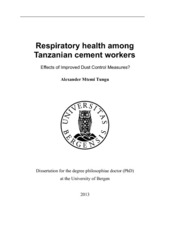| dc.description.abstract | Background: Previous studies have reported associations between dust exposure and adverse chronic respiratory health effects, but there are only a few follow-up studies among cement workers. None of the previous studies have reported on the possible health effects following improvement of dust control measures in the cement factory. Airway inflammation has recently been reported as a possible underlying mechanism of dust-related respiratory health effects. Only one study has examined FENO as a possible non-invasive marker of inflammation among cement workers. Objectives: We aimed at assessing changes in personal total dust exposure levels, chronic respiratory symptom, lung function and COPD among Tanzanian cement production workers, following improvement of dust control measures. In addition, we aimed at exploring possible associations between total dust exposure and FENO. Method: This thesis consists of four papers. In Paper I, we compared summarized group data for total dust exposure reported in 2002 with data collected in 2010–11 in the same cement factory (before vs after improvement) (n: 79 vs. 179 dust samples). Similarly, summarized group data for chronic respiratory symptoms, FEV1, FVC, FEV1/FVC ratio, COPD and % predicted values for FEV1 and FVC obtained in 2002 were compared with analogous data in 2010, among exposed workers and controls (n:120 vs. 171, and 107 vs. 98, respectively). In Paper II, a one-year follow-up on chronic respiratory symptoms was conducted among the exposed workers and controls from 2010 to 2011. Paper III compared FENO levels between exposed workers and controls (n: 127 vs 28). The FENO levels in Paper III were also compared between the exposed workers with high (GM ≥ 5 mg/m³) and low total dust exposure (GM < 5 mg/m³), and between the exposed workers in the first and second stage of cement production (n: 64 vs. 64, and 65 vs. 62, respectively). Paper IV examined possible cross-shift changes in FENO for three consecutive days among exposed workers and for two consecutive days among controls (n: 55 vs. 31). Associations between individually measured total dust exposure levels and the crossshift change in FENO were also evaluated. Results: In Paper I, total dust exposure among exposed workers was reduced in 2010–11 compared to 2002, GM: 5.8 mg/m³ vs. 10.6 mg/m³. Similarly, the proportion of total dust exposure exceeding the threshold limit value of 10 mg/m³ was lower in 2010–11 and 2002, 31%, vs. 58%. The exposed workers had higher symptom prevalence and impaired lung function compared to controls in 2002, whereas no such differences were observed in 2010. Among the exposed workers, the prevalence of chronic cough, chronic sputum production, chronic bronchitis and COPD was lower in 2010 compared to 2002. The exposed workers in 2010 had higher FEV1, FEV1% and FVC% than the exposed workers in 2002. In Paper II, the exposed workers had higher chronic respiratory symptom prevalence and overall symptoms score at baseline (2010) compared to controls, but these differences were not significant. One year later in 2011, there was significantly lower prevalence of cough, cough with sputum, dyspnoea and wheezing among the exposed workers compared to controls. In Paper III, there were similar FENO levels among exposed workers and controls (GM; 16 ppb for each group), among the exposed workers with high total and low total dust exposure (GM: 17 ppb and 16 ppb, respectively), and among workers in the first and second stage of cement production (GM: 17 ppb vs. 16 ppb, respectively). In Paper IV, we observed a statistically significant cross-shift decrease in FENO on each of the three days of examination among exposed workers, but not for the two days among controls. The cross-shift decrease in FENO among the exposed workers was not correlated with personal total dust exposure levels, correlation coefficient; - 0.175, and 95% confidence interval:-0.36 to 0.04. Conclusions: We found a reduction in personal total dust exposure, prevalence of chronic respiratory symptoms and COPD among Tanzanian cement production workers, after improvement of dust control measures, from 2002 to 2010. After one year from 2010, there was a significant reduction in the prevalence of chronic respiratory symptoms among Tanzanian cement production workers. There was no significant difference in FENO between exposed workers and controls. However, there was a significant cross-shift decrease in FENO among exposed workers. The reason for this decrease is unknown. | en_US |

